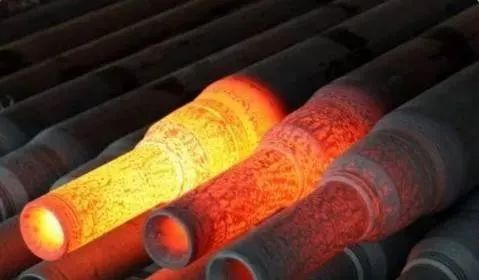Common heat treatment methods for steel
Oct. 14, 2023

Annealing
1.Processing method:
The steel parts are heated to a temperature of Ac3 +30~50℃ or Ac1+30~50℃ or below Ac1. After thorough burning and heat preservation, they are generally cooled slowly with the furnace.
2.Purpose:
① Reduce hardness, increase plasticity, and improve cutting and pressure processing performance;
② Refine grains, improve mechanical properties, and prepare for the next step;
③ Eliminate the internal stress generated by hot and cold working.
3.Application:
① Applicable to forgings, welded parts of alloy structural steel, carbon tool steel, alloy tool steel, high-speed steel, etc., as well as raw materials that are in unqualified supply status;
② Generally, annealing is performed in the rough state.
Normalizing
1.Processing method:
Heat the steel piece to 30 to 50°C above Ac3 or Accm, and then cool it at a cooling rate slightly greater than that of annealing after insulation.
2.Purpose:
The purpose of normalizing is similar to that of annealing.
3. Application:
Normalizing is usually used as a pre-heat treatment process for forgings, welded parts and carburized parts. It can also be used as the final heat treatment for low-carbon and medium-carbon carbon structural steel and low-alloy steel parts with low performance requirements. For general medium and high alloy steels, air cooling can lead to complete or partial quenching and therefore cannot be used as the final heat treatment process.
Quenching
1. Processing method:
The steel parts are heated to above the phase transformation temperature Ac3 or Ac1, kept warm for a certain period of time, and then rapidly cooled in water, nitrate salt, oil or air.
2. Purpose:
Quenching is generally to obtain a high-hardness martensite structure. Sometimes when quenching certain high-alloy steels (such as stainless steel and wear-resistant steel), it is to obtain a single and uniform austenite structure to improve its corrosion resistance and Wear resistance.
3. Application:
① Generally used for carbon steel and alloy steel with ω greater than 0.30%;
② Quenching can give full play to the strength and corrosion resistance potential of steel, but at the same time it will cause great internal stress and reduce the plasticity and impact toughness of steel. Therefore, tempering is required to obtain better comprehensive mechanical properties.
Tempering
1.Processing method:
Reheat the quenched steel parts to a temperature below Ac, and then cool them in air or oil, hot water, or water after insulation.
2.Purpose:
① Reduce or eliminate the internal stress after quenching and reduce the deformation and cracking of the workpiece;
② Adjust hardness, improve plasticity and toughness, and obtain the mechanical properties required for work;
③ Stabilize the size of the workpiece.
3.Application:
① Use low-temperature tempering to maintain high hardness and wear resistance of steel after quenching; use medium-temperature tempering to improve elasticity and yield strength while maintaining a certain toughness; mainly maintain high impact toughness and plasticity, and Use high temperature tempering when there is sufficient strength.
② Try to avoid tempering between 230 and 280 ℃ for general steel and between 400 and 450 ℃ for stainless steel, because primary temper brittleness will occur at this time.
Conditioning
1. Processing method:
High-temperature tempering after quenching is called quenching and tempering, that is, the steel parts are heated to a temperature 10~20°C higher than that during quenching, quenched after heat preservation, and then tempered at a temperature of 400~720°C.
2. Purpose:
① Improve cutting performance and improve the smoothness of the machined surface;
② Reduce deformation and cracking during quenching;
③ Obtain good comprehensive mechanical properties.
3.Application:
① Suitable for alloy structural steel, alloy tool steel and high-speed steel with high hardenability;
② It can not only be used as the final heat treatment for various more important structural parts, but also can be used as the pre-heat treatment for some precision parts, such as screws, to reduce deformation.
Aging
1.Processing method:
Heat the steel parts to 80~200 ℃, keep them warm for 5~20 hours or longer, and then take them out and cool them in the air.
2.Purpose:
① Stabilize the structure of steel parts after quenching and reduce deformation during storage or use;
② Reduce the internal stress after quenching and grinding, and stabilize the shape and size.
3.Application:
① Applicable to various steel types after quenching;
② Commonly used in precision work that requires no deformation of shape, such as precision screws, measuring tools, bed boxes, etc.
Carburizing
1.Processing method:
Place the steel part into the carburizing medium, heat it to 900-950°C and keep it warm, so that the surface of the steel part obtains a carburized layer of a certain concentration and depth.
2.Purpose:
Improve the surface hardness, wear resistance and fatigue strength of steel parts, while the core remains tough.
3.Application:
① Mostly used for low carbon steel and low alloy steel parts with a carbon content of 0.15% to 0.25%, and the general carburized layer is 0.5 to 2.5 mm;
② After carburizing, it must be quenched to obtain martensite on the surface in order to achieve the purpose of carburizing.
Nitriding
1.Processing method:
Utilize the active nitrogen atoms decomposed from ammonia at 500-600 ℃. The surface of the steel parts is saturated with nitrogen to form a nitrided layer.
2.Purpose:
Improve the hardness, wear resistance, fatigue strength and corrosion resistance of steel parts.
3. Application:
It is mostly used in medium-carbon alloy structural steel, carbon steel and cast iron containing alloying elements such as aluminum, chromium, molybdenum and so on. Generally, the depth of the nitride layer is 0.025 ~ 0.8 mm.
Carbonitriding
1. Processing method:
Simultaneously carburize and nitride the steel surface.
2.Purpose:
Improve the hardness, wear resistance, fatigue strength and corrosion resistance of steel parts.
3.Application:
① Mostly used for low carbon steel, low alloy structural steel and tool steel parts. Generally, the depth of the nitride layer is 0.02~3 mm;
② Quenching and low-temperature tempering are required after nitriding.









